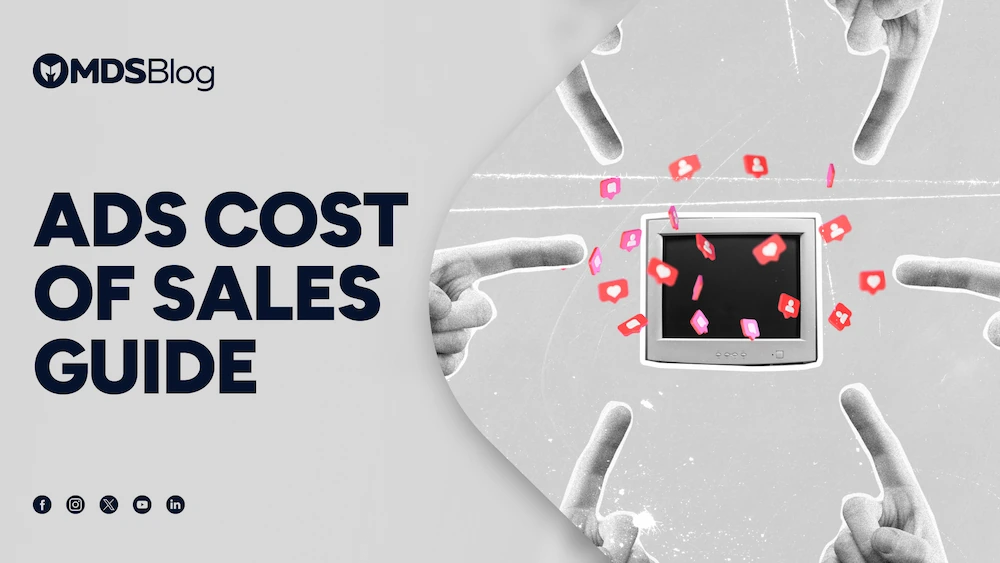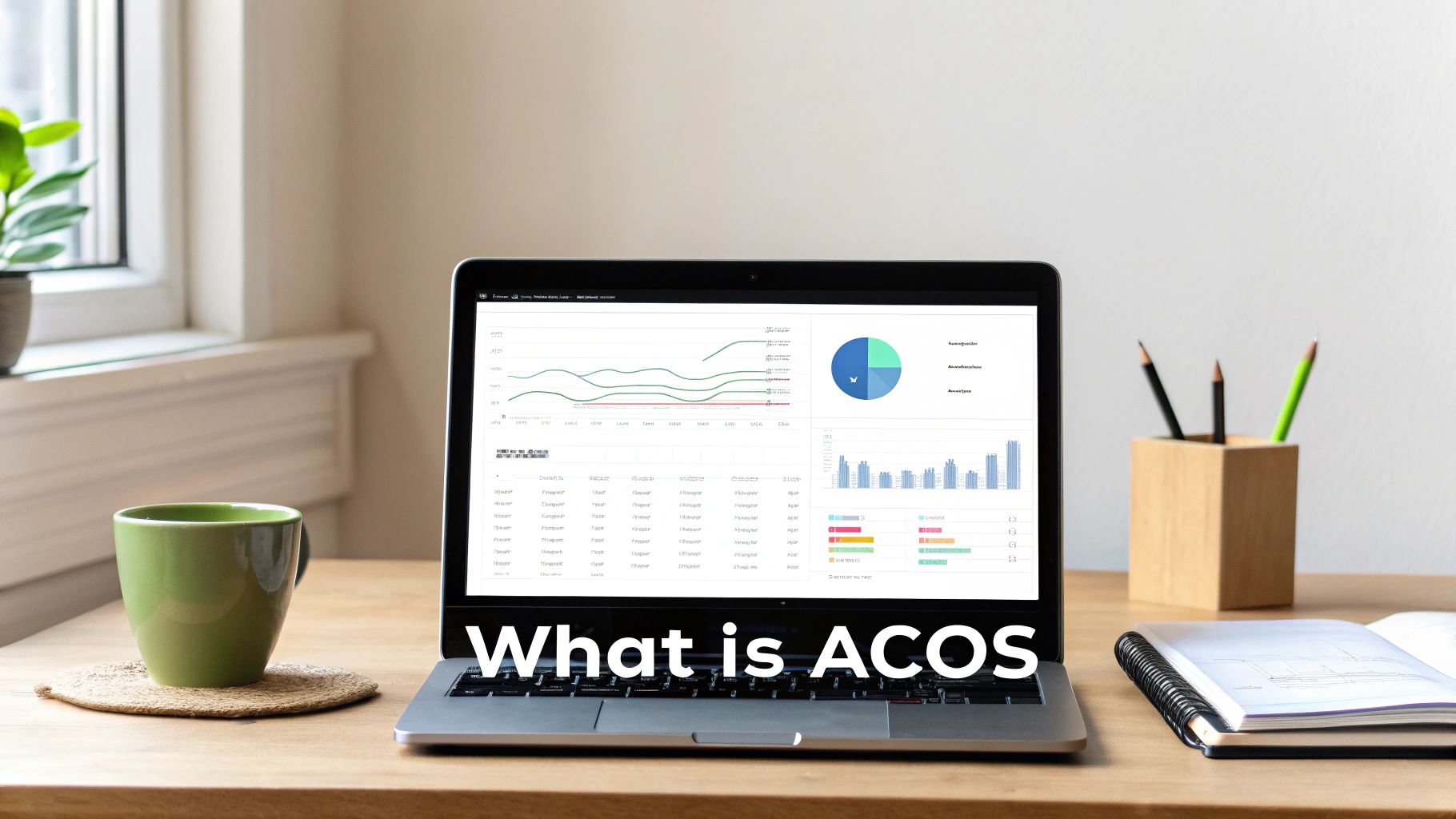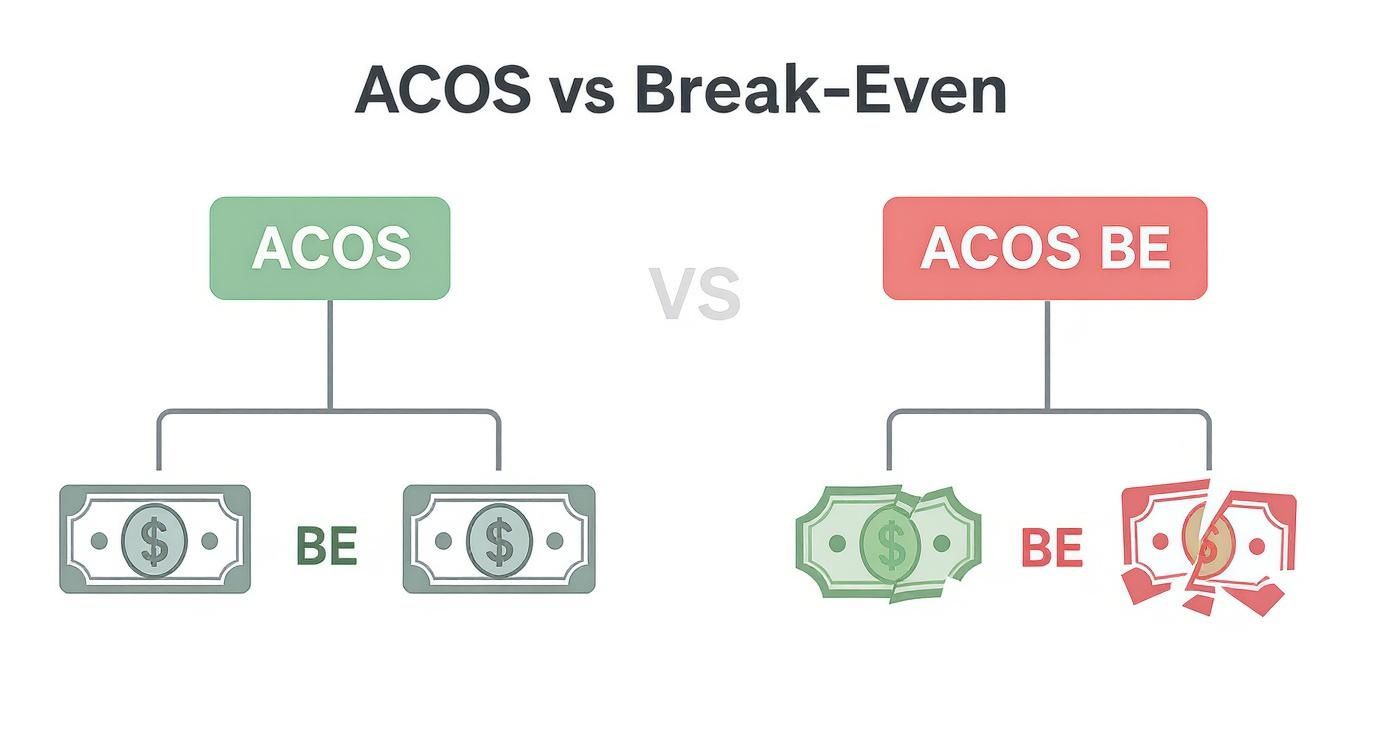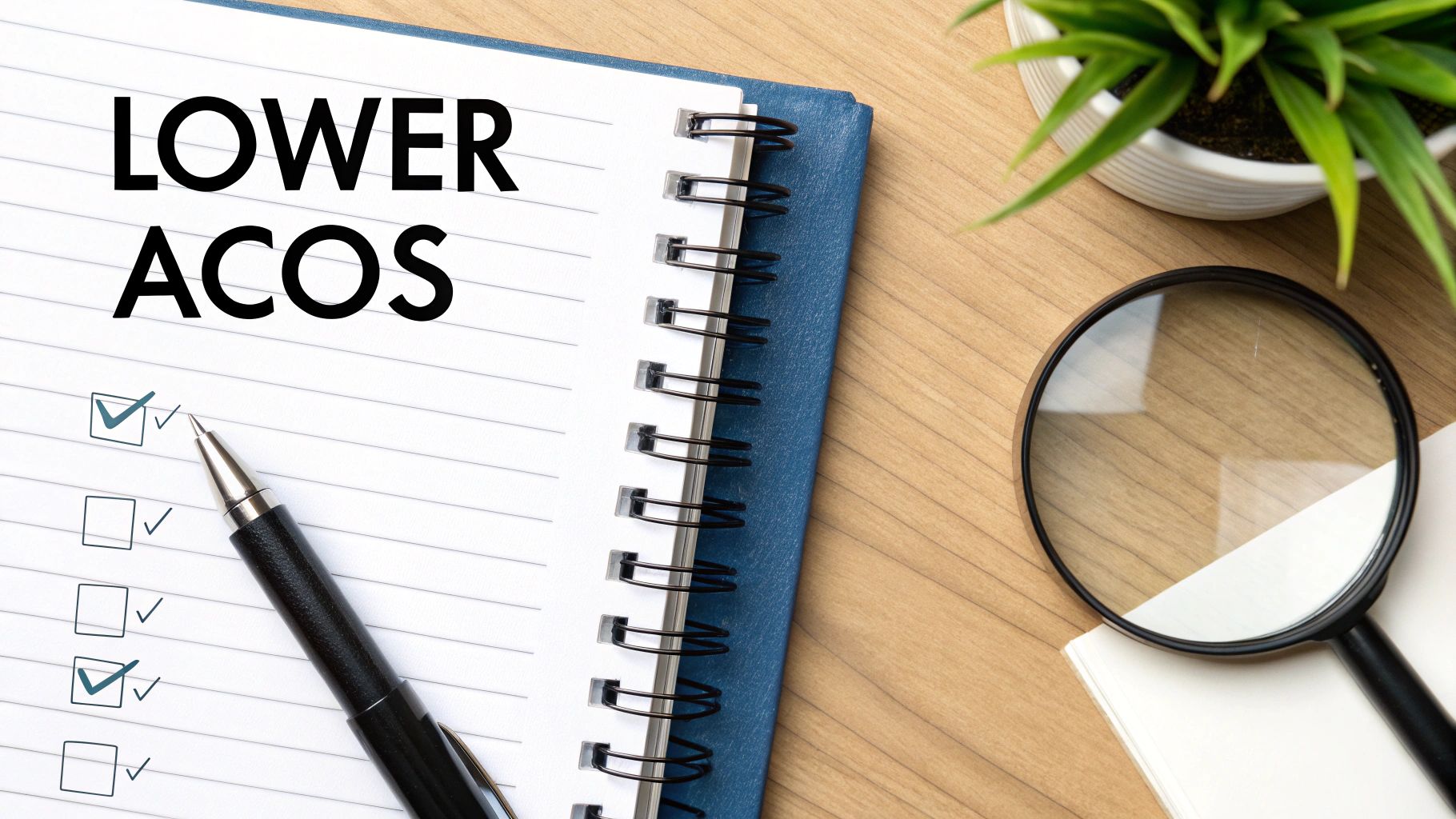Stay Updated with Everything about MDS
Thank you! Your submission has been received!
Oops! Something went wrong while submitting the form.

Chilat Doina
October 24, 2025
Alright, let's cut to the chase: ACOS stands for Advertising Cost of Sales. In simple terms, it's the metric that tells you exactly how much you're spending on ads to generate one dollar in sales. It's the number one gauge of how efficient your Amazon advertising campaigns really are.

Think of ACOS as the price you pay for visibility on Amazon. It gives you a direct, no-fluff look at how well your ad dollars are performing. For anyone running PPC (Pay-Per-Click) advertising on Amazon, this metric is non-negotiable. It’s what separates sellers who just throw money at ads from those who make strategic, data-backed decisions that actually drive profit.
Honestly, if you want to get anywhere on Amazon, you need to get comfortable with ACOS. The formula itself is refreshingly simple and cuts right through the noise.
Calculating ACOS is straightforward: you divide your total ad spend by the total ad revenue it generated, then multiply by 100 to get a percentage.
ACOS = Total Ad Spend ÷ Total Sales Revenue from Ads
Let's break it down with a quick table.
This table shows you the components of the ACOS formula with a simple example to make it crystal clear.
ComponentDescriptionExample ValueAd SpendThe total amount of money you spent on your ads.$50Ad RevenueThe total sales generated directly from those ads.$100ACOS %The percentage of sales revenue that went to ad costs.50%
So, if you spend $50 on ads and make $100 in sales, your ACOS is 50%.
Let's walk through another real-world scenario. Say you spent $200 on a Sponsored Products campaign over one week. During that same week, sales directly tied to those ads came in at $1,000.
Your ACOS for that campaign is 20%. This means for every dollar you earned in sales, you spent 20 cents on advertising. This simple percentage becomes your compass for optimizing your entire ad strategy, which we dive deeper into in our complete guide to what is PPC in Amazon.

Knowing the definition of ACOS is one thing. Understanding why it's the single most critical metric for your Amazon ads is a whole other ball game.
Without it, you're flying blind. You’re throwing money at ads and just hoping for the best. ACOS is the bright, flashing light that tells you exactly how your campaigns are performing financially.
This one little percentage separates a profitable ad strategy from an expensive hobby. It’s the heart of performance marketing, where every single dollar you spend is directly tied to a result you can actually measure. By obsessively tracking ACOS, you can finally stop guessing and start making smart, data-backed decisions.
It's easy to forget, but before Amazon developed its sophisticated ad tools, figuring out if your ads were even working was a huge headache. When Amazon Sponsored Products launched around 2012, everything changed. Sellers could finally run pay-per-click campaigns right on the platform where people were buying.
ACOS immediately became the go-to KPI. For the first time, advertisers had a clear way to measure their efficiency—how much they were spending on clicks versus how much revenue those clicks were generating. This gave sellers the power to fine-tune their spending and see, almost instantly, if their campaigns were actually making money.
This introduced a new era of accountability. Suddenly, every campaign, ad group, and keyword could be judged on its raw financial performance.
ACOS transforms your ad budget from a vague expense into a strategic investment. It gives you the clarity to cut what isn't working and double down on what is, ensuring every dollar pushes you closer to your business goals.
When you get a handle on tracking and interpreting your ACOS, you move from being a passive spender to an active, strategic campaign manager. You're in the driver's seat.
This is where the rubber meets the road. Knowing your break-even ACOS is what separates guessing from actually making money with your ads. It’s the exact point where your ad spend perfectly cancels out your profit margin on a product.
If your ACOS is higher than this number, you're officially paying Amazon to give your product away. But if you can keep it below that line, every single ad-driven sale puts cash back in your pocket.
Think of it as your non-negotiable line in the sand. It’s the single most important number for a sustainable ad strategy, telling you whether your campaigns are building your business or just draining your funds. Flying blind without it is a recipe for disaster.
Figuring this out is way simpler than it sounds. Your break-even ACOS is just your pre-advertising profit margin. Before a single dollar goes to ads, you need to know exactly how much profit you make on each unit you sell.
The formula is straightforward:
Break-Even ACOS = Pre-Ad Profit Margin %
To get your profit margin, you'll need to grab a few numbers:
Let's run through a quick example. Say you sell a bag of gourmet coffee for $25.
You make $10 on each bag before advertising. To turn that into a percentage, just divide your profit by the sale price: ($10 ÷ $25) = 40%.
So, your break-even ACOS is 40%. Any ACOS under 40% is profitable for this product.
Once you know your break-even point, you can set real, achievable goals. An ACOS of 39% means you made money. An ACOS of 41% means you lost money. That simple clarity is what allows you to make smart, data-driven decisions instead of just hoping for the best.
This concept of pre-ad profit is also tied directly to another critical business metric. To really get a handle on how these costs impact your overall profitability, check out our guide on what is contribution margin.
One of the first questions every seller asks is, "What's a good ACOS?" I get it. We all want a simple number to shoot for.
But the honest-to-goodness truth? There’s no magic number. A super-low ACOS isn't always a win, and a high one isn't automatically a failure. The "right" ACOS is all about what you're trying to accomplish with that specific product, right now.
Chasing some arbitrary percentage is a fantastic way to burn through your ad budget and leave money on the table. The real goal is to set an intentional Target ACOS (TACOS) that lines up with your business plan. This shifts you from just reacting to your ad reports to proactively steering the ship.
Are you trying to make a huge splash with a new product launch? Or are you focused on squeezing every last drop of profit from an established bestseller? Your answer changes everything.
Think about a brand-new product. Your main goal is probably getting eyes on it and generating sales velocity. You need to show up in front of as many relevant shoppers as you can to get some traction, land those crucial first reviews, and start climbing the organic rankings.
In that situation, a higher ACOS—even one that's technically losing money on each ad sale—is a smart investment. You're buying data, visibility, and long-term momentum.
Now, flip the script. For a mature, successful product, your focus shifts to maximizing profit. Here, you'll want a much lower ACOS, comfortably below your break-even point, to make sure every ad-driven sale is putting cash back in your pocket.
This little decision tree nails the core relationship between your ACOS and your break-even point.

The key takeaway is that profitability is a strategic choice. You can intentionally run at a loss (ACOS > Break-Even) to fuel growth, or you can prioritize immediate profit (ACOS < Break-Even). Neither is wrong; they just serve different purposes.
To make this crystal clear, let's look at how different goals directly impact your ACOS strategy.
The table below breaks down how your big-picture business objectives should shape your ACOS targets.
Business GoalTypical ACOS StrategyPrimary ObjectiveProduct LaunchHigh (Often above break-even)Gaining visibility and sales velocityBrand AwarenessModerate to HighCapturing market share and impressionsMaximize ProfitLow (Well below break-even)Increasing profit margins on each saleLiquidate StockVery HighClearing inventory quickly
As you can see, the "right" ACOS is a moving target. What works for a product launch would be disastrous for a profit-focused campaign, and what you do to liquidate old stock is a whole different ballgame. It all comes back to your specific, current goal for that ASIN.

Okay, so you know what ACOS is and how the math works. That's step one. Now for the fun part: taking control.
Lowering your ACOS isn't just a vanity metric—it's about making your ad spend smarter. Every percentage point you drop puts more profit directly back in your pocket from each ad-driven sale.
Sure, a high ACOS can be part of the game plan for a new product launch, but for most established products, the goal is to get that number humming along nicely below your break-even point. This doesn't happen on its own. It takes a focused, hands-on approach.
The good news? You have several powerful levers you can pull to see real improvements, fast. These aren't just theories; they're practical tactics you can start using today to stop burning cash and boost your ROI.
One of the fastest ways to slash your ACOS is to get ruthless with your keyword strategy. Stop throwing money at broad, expensive terms and zero in on what actually makes people buy.
Think of a strong negative keyword list as a bouncer for your ad budget. It stands at the door and turns away all the unqualified traffic, protecting your spend and immediately improving your ACOS.
Your ad’s job is to get the click. Your product listing’s job is to close the deal. If your listing is weak, you're essentially paying to lead shoppers to a dead end. That's a recipe for a sky-high ACOS.
You need to make your product detail page an absolute conversion machine. Focus on these four areas:
Nailing your product detail page is one of the most powerful Amazon PPC strategies out there. It makes every single click you pay for more valuable, improving both your ad performance and your organic sales. It's a win-win.
Once you start digging into ACOS, a few questions almost always bubble up. Getting these sorted out will make you much more confident in navigating the world of Amazon ads. Let's walk through the ones we hear most often.
Probably the biggest point of confusion is how ACOS relates to another popular metric, ROAS (Return on Ad Spend). They might sound completely different, but they're really just two sides of the same coin—telling the same story, just in a different language.
Here’s the simplest way to think about it: ACOS looks at your ad spend from a cost perspective, while ROAS looks at it from a revenue perspective. They are perfect inverses of each other.
Let's use a real example. If you spend $25 on ads and that brings in $100 in sales:
So, which one is better? Honestly, neither. It just comes down to personal preference. Since ACOS is the metric Amazon uses natively across Seller Central, most sellers tend to stick with it to keep things consistent.
It sounds crazy, but yes. While seeing a super-low ACOS feels like a big win—and it does mean your ads are highly profitable—an extremely low ACOS can actually be a warning sign. It often means your bids are too timid.
You might be winning the cheap, easy clicks, but you're likely missing out on a massive amount of potential sales by not bidding competitively enough. A rock-bottom ACOS is often a sign that you’re leaving money on the table. You could probably afford to bid more aggressively, capture a much larger slice of the market, and still maintain healthy profits.
Obsessing over the lowest possible ACOS can completely kill your growth. The real goal isn't just to be profitable on the sales you get, but to maximize your total profit by finding that sweet spot between advertising efficiency and sales volume.
This is where patience becomes your best friend. When you make a change—like adjusting bids or adding new negative keywords—don't expect to see the results right away. Amazon’s ad platform has an attribution delay, and it can take up to 72 hours for all the sales data from a click to be fully reported.
Because of this lag, you should always wait at least a few days, or even a full week, before you decide if your changes worked. Making knee-jerk reactions based on a single day of data is one of the most common—and costly—mistakes sellers make. Let your adjustments run their course before you decide on your next move.
At Million Dollar Sellers, we move beyond basic metrics to uncover the strategies that build 8- and 9-figure brands. Our members share what's working right now, turning complex data into actionable growth plans. See how the top 1% of sellers scale their businesses by visiting https://milliondollarsellers.com.
Join the Ecom Entrepreneur Community for Vetted 7-9 Figure Ecommerce Founders
Learn MoreYou may also like:
Learn more about our special events!
Check Events